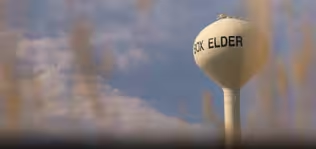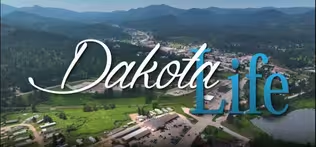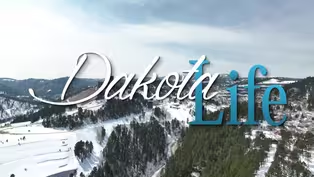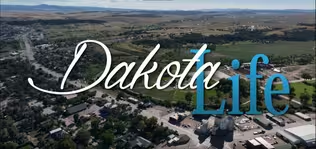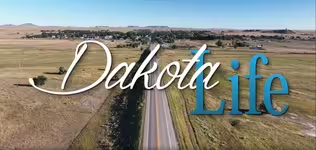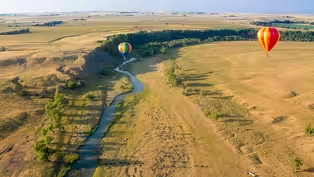Dakota Life
Greetings from Custer
Season 24 Episode 6 | 24m 56sVideo has Closed Captions
Dakota Life visits Custer and the surrounding area.
The settlement of Custer predates settlers of European descent, and after the discovery of gold, it became a bustling community that continues today. Dakota Life visits Custer and environs in February. Stories included in this episode highlight the Burning Beetle Festival, Wind Cave, Big Rock Park, and a local restaurant leading the foodie trend in Custer.
Problems playing video? | Closed Captioning Feedback
Problems playing video? | Closed Captioning Feedback
Dakota Life is a local public television program presented by SDPB
Support Dakota Life with a gift to the Friends of Public Broadcasting
Dakota Life
Greetings from Custer
Season 24 Episode 6 | 24m 56sVideo has Closed Captions
The settlement of Custer predates settlers of European descent, and after the discovery of gold, it became a bustling community that continues today. Dakota Life visits Custer and environs in February. Stories included in this episode highlight the Burning Beetle Festival, Wind Cave, Big Rock Park, and a local restaurant leading the foodie trend in Custer.
Problems playing video? | Closed Captioning Feedback
How to Watch Dakota Life
Dakota Life is available to stream on pbs.org and the free PBS App, available on iPhone, Apple TV, Android TV, Android smartphones, Amazon Fire TV, Amazon Fire Tablet, Roku, Samsung Smart TV, and Vizio.
Providing Support for PBS.org
Learn Moreabout PBS online sponsorshipMore from This Collection
Dakota Life stories from towns in western South Dakota
Video has Closed Captions
The community of Box Elder is one of the fastest-growing cities in South Dakota. (28m 52s)
Video has Closed Captions
Greetings from the ranching community of Union Center. (27m 53s)
Video has Closed Captions
Visit an artist coop, the state railroad museum, gardening enthusiasts, and an annual film (25m 49s)
Dakota Life: Postcard from Hot Springs
Video has Closed Captions
Dakota Life: Postcard from Hot Springs (29m 49s)
Providing Support for PBS.org
Learn Moreabout PBS online sponsorship(upbeat music) - [Announcer] This is a production of South Dakota Public Broadcasting.
(upbeat music) - In the beginning, Custer was a mining town, part of the gold rush unleashed by Lieutenant Colonel George Armstrong Custer's expedition here to the Black Hills.
A group of prospectors named the Gordon Party led by John Gordon, followed Custer's troops into the Black Hills, and they built an illegal stockade on the banks of the French Creek.
Initially the army expelled the Gordon Party, but eventually allowed several prospectors to return and they plotted the site of Custer City.
Now, this is a time when the towns namesake was still alive and primarily known as a civil war hero.
But unlike Deadwood, Custer never really panned out as a major gold town, but mining for other minerals was until recently a pillar of the town's economic life.
Nowadays, people flock to Custer.
They're prospecting for adventure, for the mountain views and maybe a trout or two.
Welcome to Dakota Life and greetings from Custer.
(upbeat music) - [Announcer] This program is made possible with your support and with corporate support from the First Interstate Custer Area Fund in partnership with the South Dakota Community Foundation and by Golden West Telecommunications Cooperative.
We are everywhere people connect, like Custer.
- It wasn't gold, rather copper, tin, mica, tungsten, graphite, and feldspar.
They're just a few of the minerals that miners unearthed here in the Custer area.
For many years, the economy was driven by minerals and timber.
Looking back to 1895, there were 20 sawmills in the area.
Today there's just one operational sawmill and the active mining is for rose quartz and feldspar.
Custer still relies on its natural resources, but in a much different way.
Look in any direction and you'll see natural attractions with views of black elk peak, the cathedral spires and more.
Custer has transitioned from an exporter of raw materials to a seasonal importer of people.
This area has been preparing for that transition for years.
The Black Hills Forest Preserve now known as the Black Hills National Forest was first set aside by President Grover Cleveland in 1879.
Former Governor and US Senator Peter Norbeck saw enormous potential in the Southern Hills.
In 1919 his efforts paid off when the state created Custer State Park.
And along with it came work on the ambitious Needles Highway, right through the heart of the Black Hills scenic granite core.
Every summer Custer has company.
They come by Tesla and Harley.
They wanna ride, hike, row, and climb, and they wanna soak in the natural beauty of the Black Hills.
The buzz of the sawmills has largely been replaced by the buzz about the restaurant and the shopping scene.
An old mining warehouse has been converted into the Custer beacon and you can enjoy good food and live music.
And that's just part of our story today.
Coming up, we'll take a look at a culinary tour of Custer.
We'll learn about the history and the cultural significance of Wind Cave and explore Custer's Big Rock Park.
But first we're gonna stop on Pageant Hill.
It's where Custer's annual Beetle Burn has turned a cyclical scourge into a local holiday.
(sirens wailing) - [Dave] It was an unusual community response to an environmental catastrophe.
- [Crowd] Burn beetle, burn.
Burn beetle, burn.
- [Dave] It was born out of a devastation in quotes of the Black Hills.
It was born out of the Mountain Pine beetle epidemic.
(fireworks exploding) - [Male Narrator] Back in 2012, the scenic trees of the Black Hills were going through some changes and not in a good way.
- The forest in many places along major highways was turning red.
People that came to the hills to visit Mount Rushmore, visit the caves, visit Custer State Park, or to broadly recreate across the Black Hills National Forest, they'd see all these red trees and wondering what's going on.
- [Male Narrator] What was going on was that the Black Hills was in the middle of the Mountain Pine beetle epidemic.
That would go on to destroy countless acres of trees in the Black Hills, and left the community of Custer to wonder if there was something that they could do to help educate people on the epidemic.
- There's a group of us maybe 20, that got together and talked about what was going on, and how could we bring the community together over this epidemic.
And so that resulted in January of 2013, a day we called, I think it started out being the Bark Beetle Blues.
- [Male Narrator] After the success of the first event, the committee met again with a new direction in mind.
- There was a gentleman in town, Carl Sevenson.
He was a former boat builder before he moved to Custer and he said, I think I can build a beetle, maybe 16, 20 feet long that's using the same techniques that he used to build boats.
And maybe if we put it on top of a Pyre of dead trees, maybe we could turn this into something.
- [Male Narrator] That something was the annual burning beetle.
And while the arts remain a major focus of the celebration, a new way to showcase them was the introduction of the torch mob.
- [Hank] If you've never been in a group of people with 200 torches marching to go burn something up, that's an experience that you might wanna try in your life sometime.
- [Male Narrator] It's only something you can get in January.
- January is a great time to put off a big old fire to hip hooray and have a good time because the last few years it's been surrounded by light snow cover and it's a good time to celebrate and commemorate the environment that we live in.
- [Crowd] Burn beetle, burn.
Burn beetle, burn.
(crowd cheering) - [Male Narrator] An environmental celebration that Custer hopes to keep going for many years to come.
- [Dave] This is all about bringing the community together to help us understand who it is we are and what a special place we live in.
The Black Hills are just a beautiful spot and it's home, it's really home.
And so this allows us to see who it is that we really are, I think.
- If the Beetle Burn gets the Custer residents out during the winter, it's the Custer State Park Buffalo Roundup that brings the world to Custer at the doorstep of fall.
But the silent herd of lifesize custom painted bison standing right on Mount Rushmore Road are holdovers from the customer stampede Buffalo Art Auction.
The Roundup art show adds to the festivities of the Roundup each September and a number of invited local artists had a chance to embellish their own trophy ball.
Some of that herd are right here outside of Jim and Coleen Frank's place.
It's right next to Big Rock Park.
When the Franks moved to Custer, it seemed that people had forgotten about the park.
There was a short lived experiment with a tramway in the '60s but then for a long time, nothing.
Well then the Franks moved next door and started to wonder, what if?
- Big Rock Park has been Big Rock Park for quite a few decades now.
The City of Custer designated the land that we now call Big Rock Park back in the 1930s.
However, it's been pretty much undeveloped.
The area was used for a while for the annual celebration of gold discovery days where up here on Pageant Hill, right over there.
In the late 1950s, because other small towns and other Western towns were all of a sudden on a tramway thing, everybody had to have a tramway and Custer also, well, let's get on that bandwagon and we'll attract more tourists to this beautiful drop dead gorgeous country we have here.
And so everybody got on board and sure enough, they built a tramway.
- Everything seemed to work well from the first tower to the second tower.
And then from the second tower, when it gets up closer to the mountain, it started to get pretty steep going up.
And I don't think, even the Corvair engine wasn't powerful enough, but what happened most of the time was the hydraulics would go out on it and then it just wouldn't pull.
- It didn't work.
The tramway was engineered very poorly that it didn't go.
It was supposed to be state-of-the-art, futuristic because the gondolas had their own power source, which happened to be Chevrolet Corvair engines, as opposed to what most tramways have, which is an external power source that just moves the cable that the gondolas are attached to.
But Custer, well, wanted to be cutting edge and have these Corvair engines in every gondola that they advertise it as being the first self-powered tram in the country, big deal, but it didn't work.
The engines were not up to the task.
They didn't have enough power.
They broke down and the tramway only lasted about two years before it was a complete failure and they just gave up on it and tore it down.
- We're originally from Michigan.
So when we moved out here, we were just shocked with such beautiful land and it's not being utilized.
And so that's when we really started looking around the park and thinking of different things that could be in the park and then started to write grants for it.
And one of the biggest things was, is to try to find a few points in the park where people could get to see the view of the ridge, the mountain ridge.
And, it's an incredible site especially for tourists.
- And away we went.
I mean, it was so much fun watching all that happen, especially the third phase, which involved what South Dakota Magazine calls a engineering Marvel, which is that stairway up to the top of Big Rock.
With so many federal and state trails in this area sometimes Big Rock Park is still not that well known being in a municipal park.
But anytime people are in Custer they should go to the Chamber of Commerce and find out where the skywalk trail trail-head is and just start walking.
- We were so close to never having a Buffalo Roundup or any American bison at all.
The mammal that's become a symbol of the American west just barely made it.
At the turn of the 20th Century overhunting had reduced bison herds from tens of millions to around 300, near the brink of extinction.
Strangely enough, the rebirth of the American bison began, at least partially, in New York City where the American Bison Society launched a breeding program.
In 1913, 14 bison were shipped here to Wind Cave National Park, a place known for a cave that breathes into the world above from a vast intricate maze of tunnels below.
- We're the six longest cave in the world.
We're probably right around 160 miles of explored passageway, but we're not even the longest cave in the county.
Jewel Cave with over 200 miles of passage ways is actually longer than we are.
But as like twins separated at birth.
You go on a tour of Wind Cave, you go on a tour of Jewel Cave and they're just totally different caves.
- [Larry] Just 19 miles apart by air, both Jewel and Wind Cave are in Custer County.
Tom Farrell says it's not known if the two are somehow connected, but studies have shown that the two caves breathe in different rhythm.
Yes, the caves breathe.
- Well, as it's an aptly named cave, the natural opening until the cave is very small and the cave was so large it acts like a barometer.
So you can actually predict the weather with it.
When there's a low front moving in like a storm, there's more air pressure inside of the cave than out, so the cave breathes out, if there's a high front moving in, the typically good weather, it pushes air in and you get the air flow going in the opposite direction.
It's pretty amazing what the wind can do.
What I like to do is I like to go down there on a winter day when it's softly snowing, and it's breathing out and just get the feeling there's something big down there.
- [Larry] Bigger than you imagine.
Estimates say that less than 10% of the cave has been mapped and bigger because of what's on the surface.
The cave is the star, but Wind Cave, the eighth national park created also includes a wildlife preserve for bison and elk and places to explore above and below ground.
- I mean, you can take a hike with 30 miles of hiking trails.
You can hike up the Rank and Rear, it's the highest point in the park.
It's a great place to come and have a picnic or watch sunset from there, come and go on a tour.
What's special about our cave is that you're gonna see something you're not going to see in any other cave.
This box work formation, this honeycomb formation hangs from the walls and ceilings that says we are the best example of box work found anywhere in the world.
We were kind of surprised recently when the Mars Rover had took pictures and it had a rock that appeared to be looking like box work.
So we have the best box work in the solar system.
- Part of our story is of a sacred place.
Some are told in books or oral traditions.
Some live in the hearts of the people bound to those traditions.
Wind Cave occupies both a physical and a spiritual space.
It's one of the reasons why these Black Hills are so very important to native culture.
It starts long before Europeans arrived, before the Buffalo were nearly destroyed, then reborn, before Charlie Crary or if the Bingham Brothers squeezed into the cave with a candle and some string.
The oral history of the Lakota people told of a wind that blew up from the underworld into this world.
It happened right in this place, a place both temporal and eternal, mythical and real where the Lakota people emerged into the world with a breath of life.
- The story begins at a time before there were plants and animals.
They were just being brought into existence.
There are no people, no bison on earth.
The people were in the spirit world waiting for the earth to be ready for them.
But there were two spirits on earth that trick the people by sending the wolf in carrying delicious items of food and clothing that had some of the people follow the wolf back out, while others waited following the creator's instructions.
The people that followed them out came to a beautiful place.
One of the tricksters taught them how to hunt, how to tan hides, but the people find the work very difficult, and they were very slow.
When winter arrived, they weren't ready for it.
They went back to the trickster for help, and she just laughed at them.
And they tried to return to the spirit world, but the portal was blocked.
So they didn't know what else to do so they sat down and just cried.
And the creator heard the cries and asked them why they were there.
They explained what they had done and he was very angry with them.
And so as a punishment, he turned them into bison.
When the earth was finally ready for the humans, the rest merged, they saw this track of a bison they were told to follow this bison 'cause the bison will provide everything you need to exist on earth.
And meanwhile, their creator shrank that opening down so they can never return yet never forget where they came from.
And this is part of their oral tradition, part of their emergent story in terms of that's been passed down from one generation to another.
So it really speaks to the importance of this place to the Lakota people.
- We have a link so you can see the full narration of the Lakota emergence story.
It's at sdpb.org/dakotalife.
It was in 1927, the Custer Women's Civic Club raised funds to build the Grace Coolidge Log Building.
It was a place to hold community events.
In the 1980s though, the building had fallen into disuse, but there was still a need for a community center.
So the building was repaired and in the process, a partnership began with the Rapid City YMCA.
Today, the Custer Y has a number of recreational activities for area residents to enjoy.
Meanwhile, the civic mindedness of the Custer Women's Civic Club lives on as the Grace Coolidge Log Building nears 100 years old.
All along Mount Rushmore road, a new kind of development is the talk of the town.
You see with a million visitors a year, there's a need for a full range of dining options.
There's a bakery, several cafes, sports and brew pubs, and family friendly restaurants for just about any budget.
But Custer is becoming home for several restaurants offering the kind of high-end dining experience that you might not expect to find in a small town.
Now, nevermind the scenery and the natural wonder of the Black Hills.
For foodies, the restaurants alone, make the drive, or even a short flight to Custer well worth the trip.
- [Cara] Skogen kitchen chef, Joseph Rainey is preparing a meal for a special five-course new year's Eve celebration supper.
- And then second course, we're gonna do what I'm kind of getting ready for now is a lobster cavatelli.
It's gonna be served with a lobster head, a butter sauce and then a-- - [Cara] There will also be roast duckling with sweet potato in huckleberry, a French toast featuring shaved black truffles from France, champagne sorbet, and a variety of course appropriate wines and non-alcoholic options.
So of course, Skogen kitchen is one of the region's higher end dining options.
Chef Rainey's wife, Eliza is in charge of the dining room.
- So once we put the party favorites over there, then we're gonna put everything together-- - [Cara] She feels strongly that if things aren't warm and friendly upfront, the food won't really matter.
- So it's very important that when somebody walks in, you have a smile on your face, you're happy.
Just getting them into that feeling that you're in a fine dining place, but you're still in a small town and you're kind of like at home.
- [Cara] The Rainey's started offering new year's Eve dining four years ago for two reasons, nobody else was doing it and they wanted to show some gratitude to the local and loyal customers eating at Skogen throughout the year.
- [Eliza] Some people pre-book a year in advance.
And so they just love it that much and events are really fun and especially just bringing in the new year and just kind of absorbing what happened in the past year and just with everything the past couple of years that have been going on, it's a special way to appreciate our guests and also just show people new things and then he always gets really creative with the dishes.
- [Cara] Some are amazed that a small rural town like Custer can support this kind of restaurant.
- It's absolutely shocking that a restaurant of this quality can be found in this little town in South Dakota.
This is a little piece of heaven in the Black Hills.
And when you walk through that door, all your cares are left outside.
- When we opened the restaurant, my thought in my head was, we all have this imaginative thing when we go into the mountains that we want to find that one place that's in the middle of the woods and it just has the most amazing food.
And so I'm always imagining Skogen being that place because-- - [Cara] Joseph Rainey agrees at Custer's becoming a dining destination, but gives credit to all of Custer's restaurants for their overall quality and variety.
- You have a lot of other options besides just Skogen.
And I think in a way that's kind of why we're all successful is because I think the town and the restaurants in town are just so well-rounded.
We all do very different things.
And I think that's why, I've heard people mention like Custer's becoming a foodie town.
- [Cara] Joseph Rainey is originally from Southern California and learned his trade in and around Los Angeles.
Eliza is from a small town in Minnesota.
They wanted out of the city, went looking for a new home with just the right feel and found it in Custer.
- These are the most generous and I think the best people in the world.
And I wake up every day thinking to myself, I am so glad that I took a chance and moved out of California and came here because it's a dream come true.
I mean, there's not much more to say, it's amazing.
- [Cara] This new year's Eve party marks the end of Skogen Kitchen season.
The restaurant will close on new year's day and won't reopen until early February.
It's the Rainey's chance to travel, enjoy a warmer climate and learn about the new flavors and presentations they encounter wherever they go.
No doubt Skogen Kitchen's customers will be waiting in line to see what's new on next year's menu.
- Custer is a town still in transition.
It may be close to a rival, but each new mile brings new challenges, like staffing all of those seasonal jobs that are needed to help travelers make the most of their Custer experience.
Long-time residents remember a dustier town, a town that made much of its living off the land.
Now parts of that old Custer are still rolling along, but you might miss them if you don't know where to look.
Now, several generations into its mountain gateway status the Flintstones family campground has come and gone.
Fine dining and glamping are here and now.
Still, while many people are only passing through Custer maintains a small town cohesive spirit.
You can tell by the number of people that come out for the Beetle Burn.
Residents support their local galleries and restaurants and their local YMCA.
It's a challenge to be a desirable mountain town, surrounded by public land, but there are worse challenges a town could face.
It requires some creativity.
And fortunately Custer has that in abundance.
You see, they're smart enough to live here all year round.
(upbeat music) You can replay stories from our Custer visit and other communities at sdpb.org/dakotalife.
Thanks for coming along with us to Custer.
And now we're gonna leave you with a bit of local music from the Wild Cat Flus band.
(upbeat music)
Support for PBS provided by:
Dakota Life is a local public television program presented by SDPB
Support Dakota Life with a gift to the Friends of Public Broadcasting
